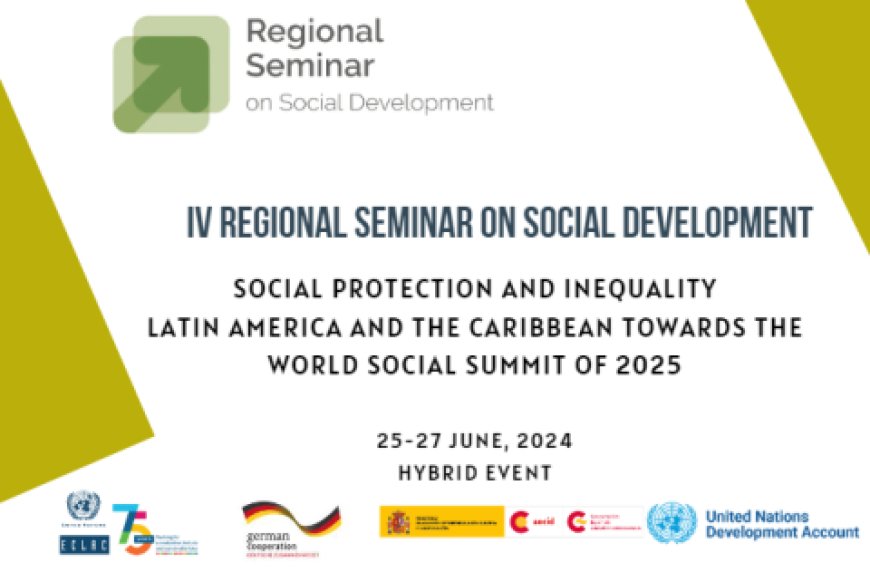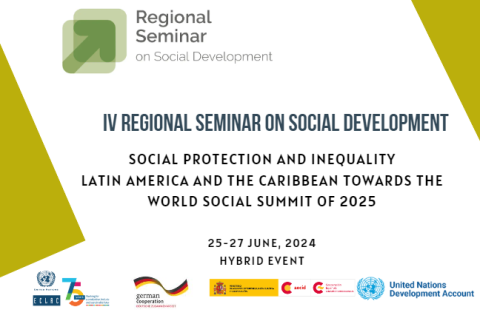IV Regional Seminar on Social Development Social Protection and Inequality Latin America and the Caribbean towards the World Social Summit of 2025
IV Regional Seminar on Social Development Social Protection and Inequality Latin America and the Caribbean ... Comisión Económica para América Latina y el Caribe

The Impact of COVID-19 on Social Development in Latin America and the Caribbean

The cascade of crises that Latin America and the Caribbean have faced since the COVID-19 pandemic in 2020 generated strong deteriorations in poverty, inequality, and employment. Although since 2022 the region has shown a slight favorable trend of recovery in several dimensions of inclusive social development (ECLAC, 2023),[1] it is still mired in a double structural trap of low growth and important levels of poverty and inequality. Inequality is a historical and structural characteristic of this region, which has been maintained and reproduced even in periods of growth and economic prosperity (ECLAC, 2016).[2]
Inequality as a Persistent Challenge
Inequality has been at the center of ECLAC’s thinking and reflections in its 75 years of existence, contributing from an analysis at the interregional level, with the proposals on center-periphery dynamics in relation to sectoral asymmetries in economic development (ECLAC, 1951),[3] to the distribution of income, wealth, and the exercise of rights. The structural heterogeneity that characterizes the functioning of the productive systems of the countries of the region, in which low-productivity sectors generate most of the employment, is one of the determinants of inequality in the region. The labour market is the fundamental link between this productive structure and income inequality. It has been argued that this structural inequality is a major barrier to the development of the countries of the region, as well as to the eradication of poverty, the expansion of citizenship and the exercise of rights (ECLAC, 2010,[4] 2012[5] and 2014[6]). It is, moreover, inefficient because it has a negative impact on productivity, taxation, and environmental sustainability (ECLAC, 2018) .[7]
The Intersecting Axes of Inequality
With the approach of the “Social Inequality Matrix” (ECLAC, 2016) as a guiding analytical framework, it is argued that, together with socioeconomic status, inequalities in economic well-being and rights are determined by structuring axes such as gender, those related to the different stages of people’s life cycle (including intergenerational inequality), ethnic-racial origin, disability, migratory status and territory (such as urban segmentation and disadvantages in rural sectors), among others. These axes intersect and combine with each other, generating a multiplicity of factors and expressions of inequality (of well-being and exercise of rights) that accumulate over time.
Vulnerability to Poverty and the Importance of Social Protection
In contexts of high labour informality and inequality, with wide gaps in the social protection systems that characterize the region, the lower strata often have to face uncertainty and individual and collective shocks at the cost of their present and future well-being. This vulnerability to poverty characterizes the middle sectors that have managed to escape poverty but, as the COVID-19 pandemic showed, any socioeconomic shock or crisis can cause them to fall back into poverty, especially when they are not sufficiently and timely covered by social protection systems.
The Role of Inclusive Social Development in Sustainable Development
Today there is widespread recognition of the relevance of addressing inequality and promoting social inclusion. This is clearly based on the rights-based approach and the recognition of the negative consequences it has on the development of capabilities and individual wellbeing. But it is also a necessary objective for economic growth and sustainable development, a centrality that is clearly highlighted in the 2030 Agenda for Sustainable Development and reflected in the public policy lines of action agreed by the countries of the region in the Regional Agenda for Inclusive Social Development (ECLAC, 2020). Progress in reducing inequality gaps is key to achieving inclusive social development and this is an inherent dimension of sustainable development in the region.
The Objective of the Seminar
The objective of this seminar is to promote reflection and dialogue to advance in the recognition, analysis of the characteristics and dimensioning of social inequality in the region. Therefore, it seeks to strengthen the design of public policies that allow progress in inclusive social development and thus progress in meeting the goals agreed by the countries in the 2030 Agenda for Sustainable Development.
References:
- [1] Social Panorama of Latin America and the Caribbean 2023: labour inclusion as a key axis of
SDGs, Targets, and Indicators
1. Which SDGs are addressed or connected to the issues highlighted in the article?
- SDG 1: No Poverty
- SDG 5: Gender Equality
- SDG 8: Decent Work and Economic Growth
- SDG 10: Reduced Inequalities
- SDG 16: Peace, Justice and Strong Institutions
The article discusses issues related to poverty, inequality, employment, and social development, which are all connected to the above-mentioned SDGs.
2. What specific targets under those SDGs can be identified based on the article’s content?
- SDG 1.2: By 2030, reduce at least by half the proportion of men, women, and children of all ages living in poverty in all its dimensions according to national definitions.
- SDG 5.1: End all forms of discrimination against all women and girls everywhere.
- SDG 8.5: By 2030, achieve full and productive employment and decent work for all women and men, including for young people and persons with disabilities, and equal pay for work of equal value.
- SDG 10.4: Adopt policies, especially fiscal, wage, and social protection policies, and progressively achieve greater equality.
- SDG 16.3: Promote the rule of law at the national and international levels and ensure equal access to justice for all.
These targets address the issues of poverty reduction, gender equality, decent work, reduced inequalities, and access to justice, which are discussed in the article.
3. Are there any indicators mentioned or implied in the article that can be used to measure progress towards the identified targets?
Yes, the article mentions indicators that can be used to measure progress towards the identified targets. These indicators include:
- Proportion of people living in poverty in all its dimensions
- Gender discrimination indicators
- Employment rates and productivity levels
- Income and wealth distribution indicators
- Access to justice indicators
These indicators can be used to assess the progress made in achieving the targets related to poverty reduction, gender equality, decent work, reduced inequalities, and access to justice.
Table: SDGs, Targets, and Indicators
SDGs Targets Indicators SDG 1: No Poverty Target 1.2: By 2030, reduce at least by half the proportion of men, women, and children of all ages living in poverty in all its dimensions according to national definitions. Proportion of people living in poverty in all its dimensions SDG 5: Gender Equality Target 5.1: End all forms of discrimination against all women and girls everywhere. Gender discrimination indicators SDG 8: Decent Work and Economic Growth Target 8.5: By 2030, achieve full and productive employment and decent work for all women and men, including for young people and persons with disabilities, and equal pay for work of equal value. Employment rates and productivity levels SDG 10: Reduced Inequalities Target 10.4: Adopt policies, especially fiscal, wage, and social protection policies, and progressively achieve greater equality. Income and wealth distribution indicators SDG 16: Peace, Justice and Strong Institutions Target 16.3: Promote the rule of law at the national and international levels and ensure equal access to justice for all. Access to justice indicators Behold! This splendid article springs forth from the wellspring of knowledge, shaped by a wondrous proprietary AI technology that delved into a vast ocean of data, illuminating the path towards the Sustainable Development Goals. Remember that all rights are reserved by SDG Investors LLC, empowering us to champion progress together.
Source: cepal.org

Join us, as fellow seekers of change, on a transformative journey at https://sdgtalks.ai/welcome, where you can become a member and actively contribute to shaping a brighter future.







